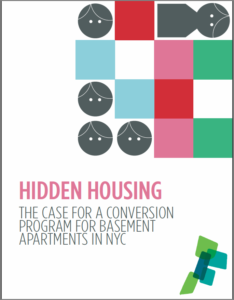The Case for a Conversion Program for Basement Apartments in NYC
At a time when new housing is urgently needed, this new CHPC study found that there are between 10,000 and 38,000 potential apartments that could be brought into safe and legal use in New York City without even changing the Zoning Resolution.
These thousands of apartments are in the basements of existing small homes, making them unusually advantageous. Basement conversions bring rental units to the market without having to acquire land. They add apartments without altering the size or shape of the building. They inherently rent for less than a similar apartment. Homeowners can pay a mortgage, maintain the property, or pay other household expenses with the rent earned on the secondary unit. Basement apartments offer housing options to underserved groups like extended families and new immigrants. A program facilitating safe and legal basement conversions would also address the urgent health and safety concerns connected with illegal occupancy, which occurs far too frequently because the demand for housing is so high.
But we know this is a challenging topic in New York and did not embark on it lightly. State and municipal regulations, and the permitting process, make it extremely difficult, or prohibitively expensive, for a homeowner to create a legal basement apartment. Many low-density neighborhoods have pre-emptively come out against any basement conversion initiative that may be employed by the City. Concerns that basement apartments may be more dangerous in a house fire must be overcome.
Before anyone decides that basement conversions are too thorny an issue, we wanted to make sure that people understand what is at stake. We believe, based on the findings we present here, that a basement conversion program for NYC would be an efficient and exciting way to add residential density and expand housing choices in our expensive and highly constrained urban market. It is also an important tool to eradicate substandard, dangerous and illegal occupancy of basements. With a basement legalization program, the City can help homeowners to unveil this Hidden Housing and make it safe, legal, and wholly suitable for thousands of New York City households.
As well as setting out our case for basement conversions, this study features CHPC’s recommendations for how a basement conversion program could be implemented. Our six recommendations for a pilot program are:
1) Identify the most suitable geographic areas for a pilot;
2) Offer homeowners some relief from parts of building regulations that are the most difficult to comply with when legalizing a basement apartment;
3) Cultivate more affordable fire suppression and prevention technologies that could be tested in the pilot project;
4) Commission and fund community-based organizations to support homeowners through the process;
5) Train and accredit architects and contractors who can appropriately undertake basement conversions;
6) Develop financial incentives so that homeowners can afford the required work, be protected against tax increases, and be encouraged to keep rents low.
The interactive map developed as part of this study also enables policymakers to assess the impact of a conversion program on a neighborhood and to site possible pilot programs. Many thanks to Carto for supporting this work.
SEE WHERE ALL THE POTENTIAL BASEMENTS ARE ACROSS NYC
This work is part of CHPC’s broader Making Room initiative which explores how alternative housing
typologies can better meet the needs of New York’s diverse households.
Special thanks to our project funders who continue to be essential partners in this
work:
Capital One
Carto
Deutsche Bank
The Charles H. Revson Foundation



